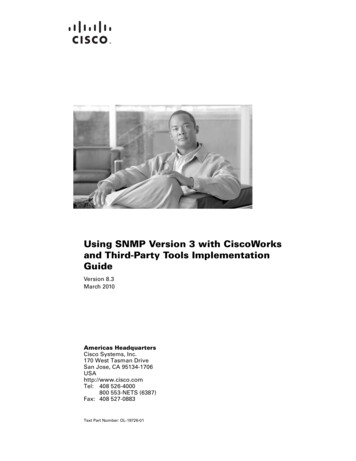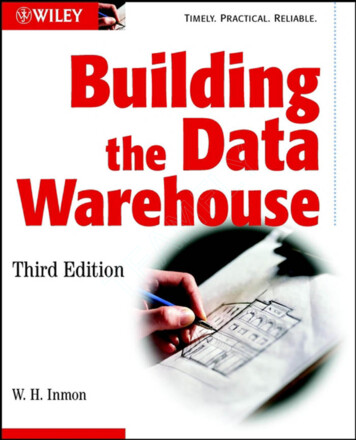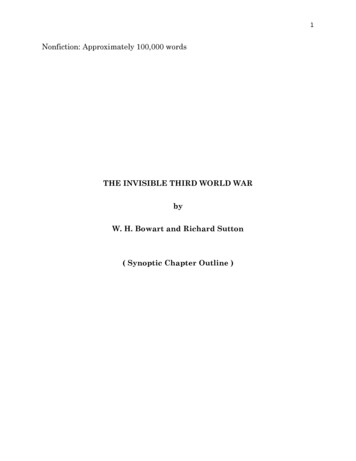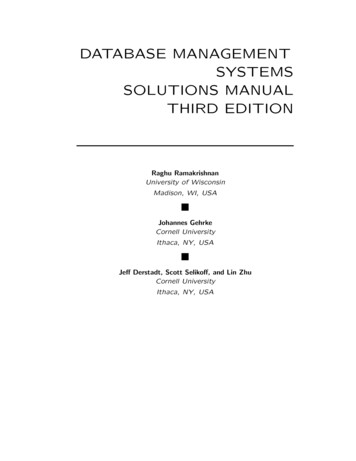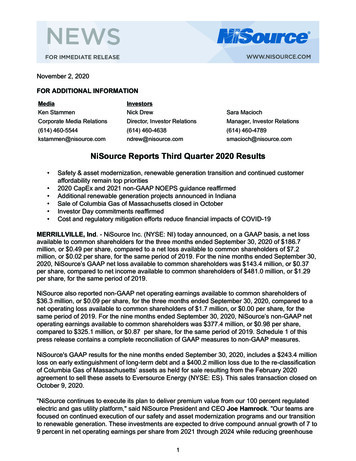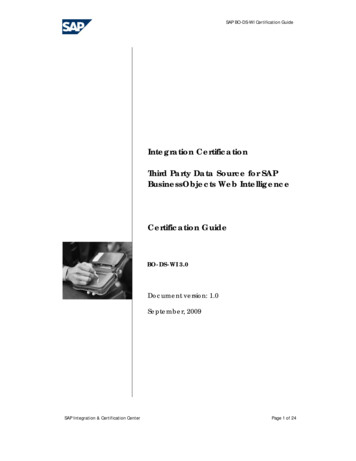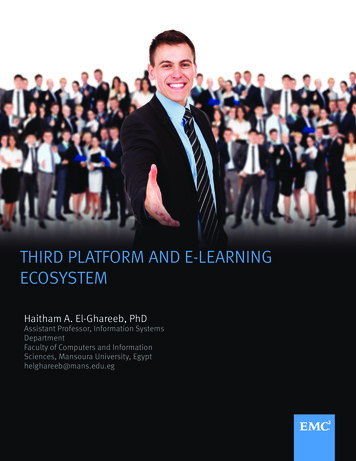
Transcription
THIRD PLATFORM AND E-LEARNINGECOSYSTEMHaitham A. El-Ghareeb, PhDAssistant Professor, Information SystemsDepartmentFaculty of Computers and InformationSciences, Mansoura University, Egypthelghareeb@mans.edu.eg
Table of ContentsList of Figures . 4e-Learning Ecosystem . 5Introduction . 5Proposed e-Learning Ecosystem Components . 6Academic Alliance in e-Learning Ecosystem .11Third Platform in e-Learning Ecosystem.14Introduction .14Third Platform Components .15Social Computing .15Mobile Computing .18Big Data Analytics .19Cloud Computing .23Proposed e-Learning Ecosystem Architecture .27Cloud Computing and Virtual Labs .30Problem Definition.30Proposed Solution.31Technical Objectives .32Proposed Architecture.33Research Design and Issues .37Massive Open Online Courses.38Introduction .38Selected MOOC’s Technology Stack .40Udacity .40Coursera .42Open edX.44Third Platform Benefits in e-Learning Ecosystem .462015 EMC Proven Professional Knowledge Sharing2
Introduction .46Pedagogical Benefits .47Enhanced Learning Experience .47Boundary-less Information and Knowledge Flow.50Technical Benefits .51Future LMS .51Sustainable IT Services .51Remote Virtual Labs .51Third Platform Concerns in e-Learning Ecosystem .54No Clear Added Value .54No Clear ROI Model .54Ethical and Social Implications .54Third Platform Research in e-Learning .55Marking Large Scale Complex Assessments .55Realities of Interacting .55Metrics of Students’ Effectiveness .56Personalized e-Learning .56Third Platform Future in e-Learning Ecosystem .57Smarter Universities .57Virtual Campus and Group Awareness .57Educational Virtual World .57Social Networks Analysis in e-Learning .58Conclusion .59Acronyms .62Bibliography .632015 EMC Proven Professional Knowledge Sharing3
List of FiguresFigure 1: Proposed e-Learning Ecosystem Components .10Figure 2: e-Learning Ecosystem Coverage Areas .10Figure 3: Different Ways People Learn .14Figure 4: Cloud Computing Adoption Eff ect on e-Learning Ecosystem .26Figure 5: Proposed e-Learning Ecosystem Architecture.28Figure 6: Proposed Virtual Labs e-Learning Architecture .33Figure 7: Proposed Solution Subsystems.35Figure 8: Cloud Manager Role .35Figure 9: EMC and VMWare based Virtual Lab Data Center Architecture .36Figure 10: Bloom’s Taxonomy Revised .47Figure 11: Bloom’s Taxonomy Deliverables .48Disclaimer: The views, processes or methodologies published in this article are those of theauthor. They do not necessarily reflect EMC Corporation’s views, processes or methodologies.2015 EMC Proven Professional Knowledge Sharing4
e-Learning EcosystemIntroductione-Learning is the learning process revolution enabled by new technologies that, hopefully, willpresent an effective and efficient learning process that doesn’t exist today [26]. LearningManagement System (LMS) is responsible for learning activities. e-Learning is not just forstudents in universities. Technologies presented in e-Learning are helpful for lifelong learning,social learning, and organizations delivering training and education internally to employees andthrough professional services [65]. Continuing education is an important activity for the activeinvolvement in a social environment and enhancement of competitiveness. e-Learning might bethe only way for continuing education in many cases. A natural ecosystem is a biologicalcommunity of interacting organisms and their physical environment. Digital Ecosystem is adigital environment populated by digital species that can be software components, applications,online services, information business models, and other components [71]. In other terms, adigital ecosystem is a widespread type of computing environment comprised of ubiquitous,geographically dispersed, and heterogeneous species, technologies, and services [22]. Anecological and holistic approach is required for an improved learning environment [11]. If eLearning is to be effective in providing greater access to education and support educationalprograms that reflect broader strategic business goals, it is important that the e-Learningindustry learns key lessons from its early adopters from business such as CustomerRelationship Management (CRM), and Enterprise Resource Planning (ERP). Extending thedigital ecosystem to e-Learning defines an e-Learning Ecosystem as the learning community,together with the enterprise, united by LMS [71].Platforms are creating an entirely new blueprint for competition, one that puts ecosystems inhead-to-head competition [69]. The Open Group defines a platform as the combination oftechnology infrastructure products and components that provide the prerequisites to hostapplication software [1]. Third Platform is a loosely-defined computing platform that includestechnologies becoming commonly available early in the second decade of the twenty-firstcentury, mainly: Social, Mobile, Analytics, and Cloud (SMAC) [33]. Current models of e-Learningecosystems lack the support of underlying infrastructures, which can dynamically allocate therequired computation and storage resources for e-Learning ecosystems [21]. Third Platform is apromising platform for the e-Learning ecosystem. Monolithic and services-based LMS hasturned into social and cloud-based Massive Open Online Courses (MOOC) that are availablethrough mobile devices to serve hundreds of thousands of students with the help of Third2015 EMC Proven Professional Knowledge Sharing5
Platform. Remote and virtual Labs has become available through Third Platform too. This is justthe beginning. Universities and learning institutions that fail to pay attention to the importance ofThird Platform in e-Learning ecosystems will face tough sustainability challenges. Third Platformwill certainly bring new players to the e-Learning ecosystem, open new opportunities, and makeserious challenges to learning institutions. e-Learning providers, consumers, contentdevelopers, and stakeholders in e-Learning are experiencing the revolutionary era of ThirdPlatform in e-Learning ecosystems.In this article, e-Learning ecosystem evolution is highlighted, and an e-Learning ecosystem isproposed. Third platform components (SMAC) and how they fit in e-Learning ecosystem ispresented in detail with examples of applied research and case studies. The technology stack ofsome of the famous MOOCs is presented. Importance of adopting third platform in e-Learningecosystem and some the benefits is illustrated. Mechanisms to utilize Cloud Computing inVirtual Labs and how such a scenario can solve e-Learning challenges is introduced. Thirdplatform concerns in e-Learning ecosystem is then discussed in brief. Research trends currentlytaking place to adopt third platform in e-Learning ecosystem is introduced. Glimpses of thefuture of third platform in e-Learning ecosystem are depicted.Proposed e-Learning Ecosystem ComponentsA generalized view of e-Learning ecosystem domain that is based on the abstract definition ofan ecosystem is presented in [11]. Natural ecosystem is classified into biotic and abioticcomponents and all their interrelationships is specified within physical boundaries. Transformingthat to the learning domain, an abstract definition of e-Learning ecosystem consists of thestakeholders incorporating the whole chain of the learning process and the learning utilities, thelearning environment, within specific boundaries, called learning environmental borders. As thebiotic units in the ecosystem the learning communities and other stakeholders such as teachers,tutors, content providers, instructional designers, and pedagogical experts, form the living partsof the e-Learning ecosystem. The learning utilities comparable to the abiotic units (or thelearning environment comparable to the physical environment) represent the non-living parts,which include the learning media (content and pedagogical aspects), technology, and toolsapplied in traditional teaching methods. The learning environmental boundaries – an analogy tothe specified physical boundaries of the ecosystem – defines the physical and logical borders ofthe learning system. That is one of the system’s characteristics, which are in common specifiedas the e-Learning ecosystem conditions. These conditions are determined by external andinternal influences, such as evolution of knowledge, educational goals, learning tasks, cultural2015 EMC Proven Professional Knowledge Sharing6
and sociological aspects, and expectations by society, private industry and businessorganizations, the government, public service and not-for-profit organizations. Finally, in order todefine a concrete model, the temporal extent and the temporal and spatial scale of the systemhas to be specified. A simplified view of components in an e-Learning ecosystem consists of:Content Providers, Consultants, and Infrastructure [22].1. Content Providers: Content providers offer content for learning solutions that istypically linked to competency development, personal development, or a criticalbusiness issue requiring improvement. There are three types of content providers:Branded Content Provider, Commodity Content Provider, and Custom ContentProvider. Many e-Learning solutions utilize a combination of all three.a. Branded Content Provider: typically associated with a leading publisher orbusiness school.b. Commodity Content Provider: a content aggregator that offers hundreds oftitles, courses, and modules in a variety of formats.c. Custom Content Provider: an organization that will tailor internal contentand/or develop new content based on a specific requirement. Each group ofcontent providers provides a different value proposition.2. Consultants: There are four types of consultants in the e-Learning ecosystem:Strategy Consultant, Compensation Consultant, Information Technology (IT)Consultant, and Implementation Consultant.a. Strategy Consultant: Helps an organization develop a new businessstrategy. Strategy consultants typically begin with a model and tailor it to thespecific circumstances. They are usually very good at the process ofdesigning a new e-Learning structure, but weak when it comes toimplementing it.b. Compensation Consultant:Specializes in developing compensationstrategies designed to ensure employees are motivated to achieve businessgoals. Although compensation is often not directly linked to the other parts ofthe ecosystem, it should be reviewed to ensure people are motivated to helpmeet business goals. For example, an organization may have a strategy fordeveloping and launching new products, but compensate employees on theirability to manage costs and assets.2015 EMC Proven Professional Knowledge Sharing7
c. IT Consultant: Helps organizations set up the infrastructure required toperform e-Learning and the processes to operate efficiently and seamlessly.d. Implementation Consultant: Helps organizations put new systems,strategies, and plans in action. They work with IT teams and strategy groupsto successfully implement a new system.3. Infrastructure: The enabler for management, delivery and tracking of e-Learning. Itconsists of LMS that provides content delivery system and tools. Infrastructure canbe categorized into LMS, Content Delivery System (CDS), and tools.a. LMS is a software solution that enables organizations to efficiently managethe process of training and development. The benefit of LMS is its ability tobe online, providing instant access to data and information regarding the useand effectiveness of training. LMS also enables organizations to generatereports specifying who has been to which programs, how they did it, whatelse they are signed up for, and much more. LMS must be able to manage allforms of learning, including instructor-led, asynchronous, and synchronous eLearning.b. CDS is online software that allows training to be delivered over the Internet.The two types of CDS are asynchronous and synchronous.i. Asynchronous CDS use open platforms and development standardsto physically design and deliver the content for anytime access.Asynchronous content delivery systems provide many interactivefeatures that leverage the full power of the Internet, such as chats,peer counselling, communities, coaching, and document sharing.ii. Synchronous CDS enable the simultaneous online delivery ofcontent to a group of people at a specified time.c. Tools transfer core intellectual property into a Learning Object (LO). Thesetools are used to create content that fully engages the learner and increasesmemory. In an educational context, digital learning content is produced,administered, and manipulated in an intricate and changing environment.2015 EMC Proven Professional Knowledge Sharing8
Research directions found in scientific literature that is related to IT and e-Learning ecosystemare identified within three main research directions [65]:1. IT ecosystem approach to improve the educational process which comprises thedefinition of elements of the educational process and reflection of interaction of theprocesses.2. IT ecosystem approach to support the educational process which provides theapplication of natural ecosystem principles in analysis and development ofeducational IT.3. Analysis and modelling of knowledge flow both at the university and in aproduction company.It is clear from the previous discussion that there is no agreed upon definition of e-Learningecosystem. However, by surveying different proposed e-Learning ecosystems, a general modelcan be obtained. Identifying the e-Learning ecosystem components varies greatly from onesystem to another. From our perspective, Third Platform will shape e-Learning ecosystem.Figure 1 presents a proposed e-Learning ecosystem as considered in this article. e-Learningecosystem does not address training needs only, however it exceeds what is known asstructured learning to reach wider areas. Figure 2 introduces the domains that e-Learningecosystem needs to cover as presented in [61].2015 EMC Proven Professional Knowledge Sharing9
Figure 1: Proposed e-Learning Ecosystem ComponentsFigure 2: e-Learning Ecosystem Coverage Areas2015 EMC Proven Professional Knowledge Sharing10
Academic Alliance in e-Learning Ecos
turned into social and cloud-based Massive Open Online Courses (MOOC) that are available through mobile devices to serve hundreds of thousands of students with the help


